Hybrid inverter for solar panels: types, overview of the best models + connection features
Electricity supply systems with the simultaneous use of the traditional supply of current and electricity from the sun are an economically viable solution for private home ownership, cottage, summer cottages and industrial premises.
An indispensable element of the complex is a hybrid inverter for solar batteries, which determines the modes of voltage supply, ensuring the uninterrupted and efficient operation of the solar system.
In order for the system to work efficiently, you need not only to choose the optimal model, but also to connect it correctly. And how to do this - we will analyze in our article. We also consider the existing types of converters and the best offers on the market today.
The content of the article:
Hybrid Inverter Capability Assessment
Using renewable solar energy in combination with a centralized power supply offers several advantages. The normal functioning of the solar system is ensured by the coordinated operation of its main models: solar panels, charge controller, battery, as well as one of the key elements - the inverter.
Solar system inverter - a device for converting direct current (DC) from photovoltaic panels into alternating electricity. It is at a current voltage of 220 V that household appliances work. Without an inverter, generating energy is pointless.
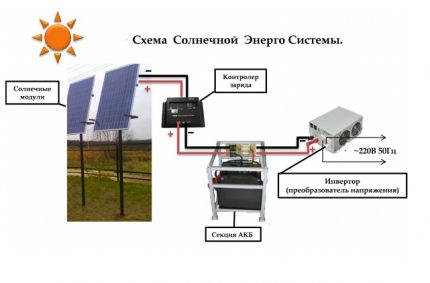
It is better to assess the capabilities of the hybrid model in comparison with the features of the work of its closest competitors - autonomous and network "converters".
Converter type network
The device operates on a shared mains load. The output from the converter is connected to consumers of electricity, AC network.
The scheme is simple, but has several limitations:
- operability at availability of alternating current in a network;
- mains voltage must be relatively stable and consistent with the operating range of the converter.
The variety is in demand in private homes with the current "green" tariff for electrification.
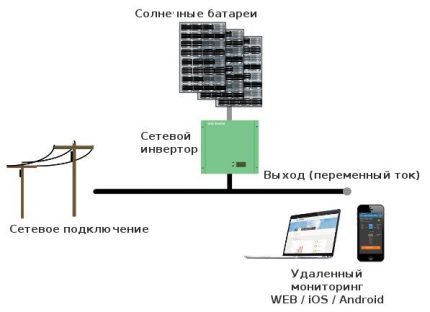
Standalone version of the device
The device is powered by batterywhich receives a charge from solar panels through the MRPT controller. The system uses different types of batteries, including high-tech lithium batteries.
At the maximum “filling” of the storage device, excess electricity is transmitted to the inverter input, the output of which is connected to the end users of the AC.
In the event of a lack of solar activity, energy is taken from the storage batteries and passes “conversion” through the voltage inverter.
Features of the autonomous installation:
- the possibility of independent operation in the absence of AC power;
- some models support the “green” tariff mode of operation;
- The efficiency of the installations is 90-93%.
To ensure the absolute autonomy of the object requires accurate calculation of solar power and sufficient battery power.
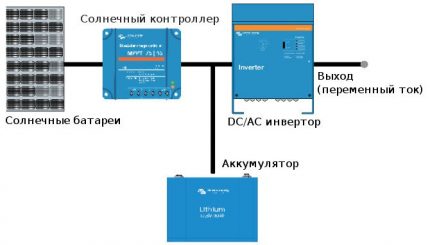
Hybrid Inverter Type
The model differs from the devices described above in a special “architecture” of manufacture. A special electrical circuit is provided inside, which allows in parallel operation with the current source (mains, generator) in the converter mode.
At the same time, the load is supplied from the central network and solar panelswhile the priority function is assigned to the DC supplier.
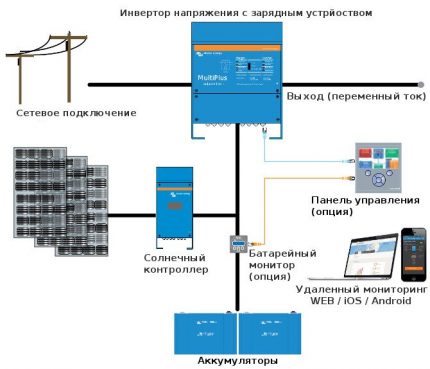
Competitive advantages lie in the multifunctionality of hybrid inverters:
- Network - A kind of roomy battery with an efficiency of 100%. All surpluses generated by photovoltaic plates can be redirected to the central network at a “green” tariff.
- Uninterruptible Power Supply. When you turn off the main power supply, the system is rebuilt into offline mode, protecting all consumers from voltage surges.
- Increased network capacity limit during peak loads due to the addition of energy from the battery-inverter complex.
With a decline in consumption, the solar complex switches to charging mode and is ready for use again after a while. Double power function can be indicated: Smart Boots, Power Shaving, Grid support.
The addition of power occurs according to the following principles:
- if the used power is lower than the maximum network consumption, then in addition to supplying the load, the battery is charged;
- in the absence of voltage in the network, energy is consumed from the battery and converted by the inverter;
- if the load exceeds the limit value of the power of the network, then the deficiency is compensated by the accumulated electricity from the solar battery.
The listed operating modes are capable of supporting hybrid models with a charger.
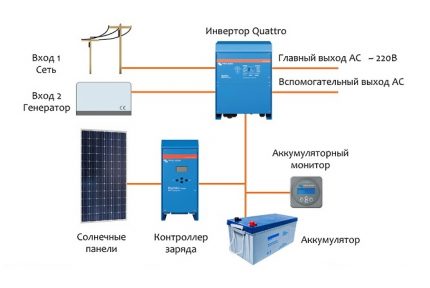
Varieties of current converters
Choosing the "heart" of an autonomous power supply system, you should correctly compare the tasks assigned to the equipment with its potential capabilities.
The main features of the classification of hybrid inverters are: an algorithm for changing operating modes, the shape of the output voltage and the ability to service a single or three-phase network.
Comparison of UPS and Hybrid Installation
Some companies inadvertently mislead the consumer, calling the uninterruptible power supply unit (UPS) a hybrid inverter. It would seem that both devices perform similar tasks, but there is a significant difference.
BBP is an inverter with a charger. The module primarily provides energy consumption from a photovoltaic installation, and if it is lacking, it switches to consumption from the network.
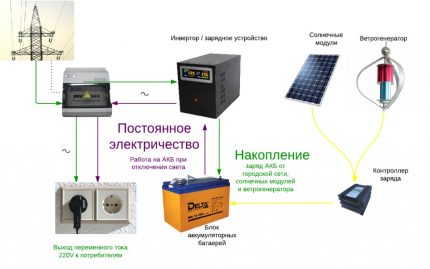
The functioning of the system in “jerking” mode provokes additional cycling of the battery and accelerates its wear. In most inexpensive power supply systems, the threshold voltage is set without regulation.
In the models of hybrid inverters for solar batteries, such surges are excluded - the unit adjusts to the required power and works simultaneously with different current sources.
You can choose priority consumption yourself. As a rule, the emphasis is on the use of energy from solar panels. Some hybrid units have the option of limiting the power coming from the city network.

Variety of inverter waveforms
Solar current converters are classified by the type of output signal.
Distinguish:
- pure sine wave;
- modified sine (quasi-sine wave);
- meander.
The latter option is practically not used in practice, since a sharp change in polarity causes equipment malfunctions.
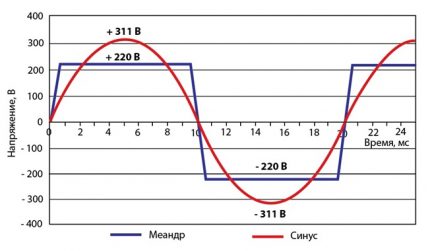
What is a pure sine wave?
The converter produces a high-quality signal that exceeds the shape of the mains current. This is the best option for the operation of “sensitive” equipment: heating boilers, compressors, electric motors, medical equipment and devices based on transformer power supplies.
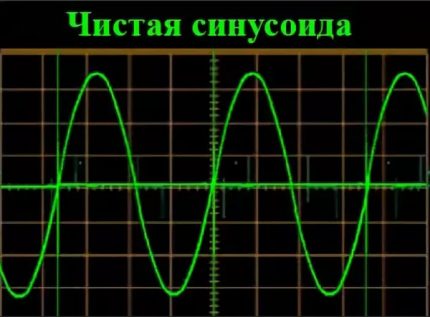
Quasi-sine features
Energy signal transmission in the form of a modified sine wave can reduce the efficiency of some devices, provoke the appearance of noise, cause interference or damage equipment.
When powered by low-frequency transformers, asynchronous, synchronous motors, a power loss of 20-30% is visible. This "defect" is converted into thermal energy, overheating the devices.
Pseudo-sinusoidal inverters are compact and affordable. Their use is advisable for powering devices without inductive loads, designed for the consumption of active components of electric power.
This group includes: thermoelectric heaters, incandescent lighting systems and other resistive structures.
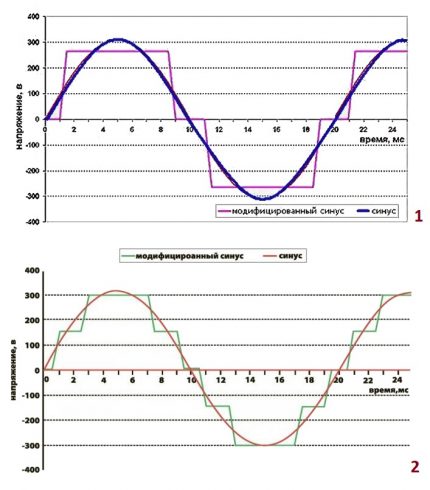
The shape of the output signal is indicated in the passport of the inverter or uninterruptible. Possible notation: “Back” - a guarantee of the absence of a pure sine, “Smart” - the probability of obtaining a high-quality current at the output.
Some manufacturers in the accompanying document note the harmonic coefficient (index of nonlinear distortion). If the parameter is less than 8%, then the unit produces an almost perfect sine.
Single phase and three phase models
Single-phase inverters are mainly built into the circuit of a domestic photovoltaic system with a standard voltage of 220V.
The output voltage range when connected to one phase in different models ranges from 210-240V, the output frequency is 47-55 Hz, and the power is 300-5000 watts.
Single-phase inverters are available under standard battery voltage values: 12, 24 and 48 V. In order for the converter to not function at the limit of capabilities, it is necessary to coordinate the power of the “converter” with the voltage of the solar battery or battery.
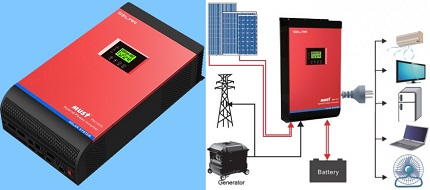
Three-phase inverters are used to supply three-phase current, providing power to electric motors.Primary application - production, workshops, commercial use.
Inverters for three phases are characterized by high power (3-30 kW), a wide range of output AC voltage (220V / 400V).
Combined models are also on the market. These include single-phase inverters with the ability to synchronize the outputs of the converter with a phase shift - this allows you to power three-phase loads. All types of techniques for converting current from solar panels, we reviewed in our other article.
Solar Inverter Selection Parameters
The efficiency of the converter and the entire power supply system largely depends on a competent choice of equipment parameters.
In addition to the above characteristics, you should evaluate:
- output power;
- type of protection;
- working temperature;
- installation dimensions;
- Efficiency
- availability of additional features.
Further we consider all these characteristics in more detail.
Criterion # 1 - device power
The rating of the “solar” inverter is selected based on the calculation of the maximum load on the network and the estimated battery life. In start-up mode, the converter is able to give a short-term increase in power at the time of commissioning of capacitive loads.
This period is typical when you turn on dishwashers, washing machines or refrigerators.
When using lighting lamps and a TV, a low-power inverter for 500-1000 watts is suitable. As a rule, the calculation of the total power of the operated equipment is required. The required value is indicated directly on the device body or in the accompanying document.
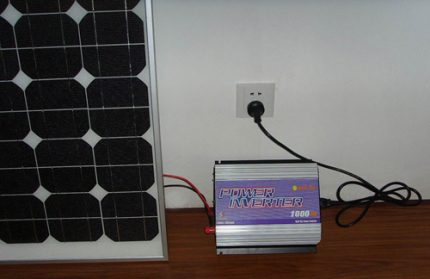
Criterion # 2 - protection level
A high-quality solar inverter must have several levels of protection. Possible options: forced cooling system, short circuit warning, protection against voltage dips and surges.
It is also important - the presence of a sealed fortified housing that prevents dust, moisture from entering the inside. The electrical protection rating is standardized according to IEC-952 standardization.
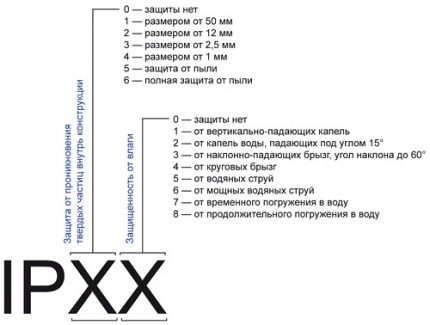
For outdoor operating conditions, models with the IP65 index are suitable - the strength and reliability of the inverter allows its use in an external atmosphere.
Criterion # 3 - operating temperature and dimensions
A wide range of values is an indicator of a decent build quality of the inverter. The value of the indicator is especially relevant when placing the converter in an unheated room.
Weight is an indirect indicator of the quality of the inverter. There is an opinion - the heavier the converter, the more powerful it is. This is due to the presence of a transformer in high-power equipment.
In "lightweight" models, the absence of a transformer can cause inverter failure when a high inrush current is applied.
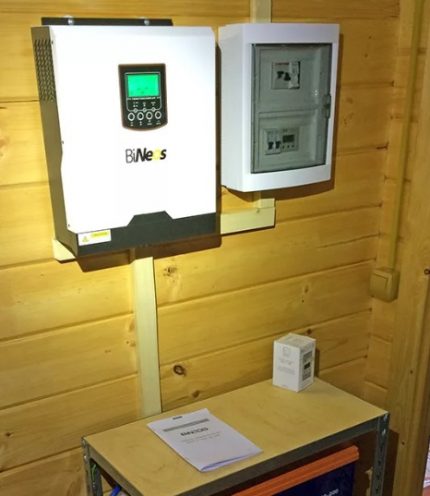
Criterion # 4 - coefficient of performance
Experts recommend purchasing current “converters” with an efficiency of 90%. Only with this parameter will the work of the solar system be effective, and its arrangement expedient. The loss of 10% of solar energy is an unacceptable "luxury".
Additional functionality. Advanced features affect the cost of equipment and are not always in demand. However, some options justify the money spent.
Useful and necessary “devices” include:
- automatic addition of inverter power to the grid electricity;
- adjustment of the battery charging period;
- selection of priority current source;
- maintenance of work with batteries of various types (alkaline, lithium iron-phosphate, helium, AGM, acid);
- the possibility of combined work with a network converter;
- setting the voltage indicator - warning of “surges” in mains voltage;
- the ability to upgrade the inverter by updating the firmware.
Modern converters can be connected to a PC for programming and monitoring.
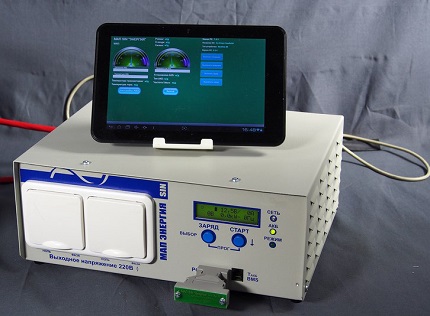
Overview of Popular Hybrid Converters
Inverters from foreign companies received good reviews among consumers: Xtender (Switzerland), Prosolar (China), Victor Energy (Netherlands), SMA (Germany) and Xantrex (Canada). Domestic representative - MAP Sine.
Xtender Multifunction Inverter Line
Xtender's Studer Hybrid Converter is the epitome of Swiss quality standards in power electronics. Xtender Series Solar Inverters are distinguished by their indicative strength characteristics and extensive functionality.
A variety of models: ХТS - low-power representatives, ХТМ - medium power models, ХТН - high-power inverters.
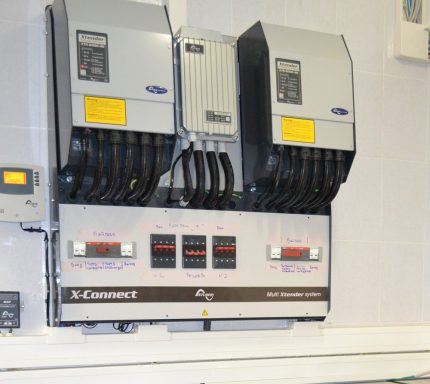
Each Xtender Hybrid Drive Series has the following features and options:
- pure sine wave feed;
- "Mix" of power to the network from the battery;
- when the mains voltage decreases, the consumption from the central power supply decreases;
- two priority selection modes: the first is “soft” with recharge from the network within 10%, the second is full switching to the battery;
- variety of installer settings;
- backup generator control;
- standby mode with a wide range of regulation;
- remote monitoring of system parameters.
In all versions there is a Smart Boost function - connecting to different “suppliers” of power (generator set, mains inverter) and Power Shaving - guaranteed coverage of peak loads.
Optimum Prosolar Hybrid Converters
The Chinese-made model has good characteristics and an acceptable cost (about 1200 cu). The inverter optimizes the performance of solar cells by storing unspent energy in the battery.
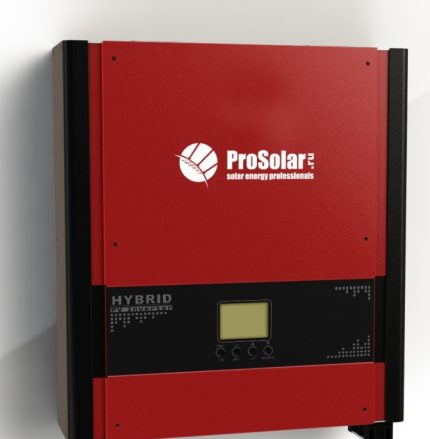
Distinctive features:
- option for tracking the limit point of the solar battery;
- information LCD display with the display of the operating parameters of the system;
- 3-level battery charger;
- adjustment of the maximum current to 25A;
- communicator inverter.
The converter is connected to the PC via software (supplied as a kit). It is possible to upgrade the inverter through innovative flashing.
Sine Wave Inverters Phoenix Inverter
Phoenix inverters meet the highest demands and are suitable for industrial applications. The Phoenix Inverter series is released without a built-in charger.
The converters are equipped with a VE.Bus information bus and can be used in parallel or three-phase configurations.
The power range of the model range is 1.2-5 kW, the efficiency is 95%, the voltage type is a sinusoid.
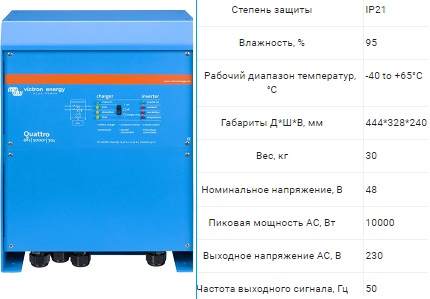
Competitive advantages:
- SinusMax technology supports the launch of “heavy loads”;
- two modes of energy conservation - the option of finding the load and lowering the no-load current;
- presence of an alarm relay - warning of overheating, insufficient battery voltage, etc .;
- setting programmable parameters via PC.
To achieve high power, up to six converters can be connected in phase in parallel. For example, a combination of six devices with a nominal value of 48/5000 can provide an output power of 48kW / 30kVA.
Domestic devices MAP Gibrid and Dominator
The company MAP "Energy" has developed two modifications of the hybrid converter: Gibrid and Dominator.
The range of equipment capacities is 1.3-20 kW, the time interval for switching between modes is up to 4 ms, the possibility of "pumping" electricity into the city network is provided.
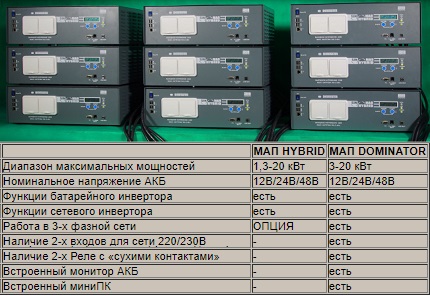
General characteristics of Gibrid and Dominator voltage converters:
- torus-based transformer;
- input voltage stabilization is absent;
- power swap mode;
- output - pure sine;
- generating an excess of energy in the network;
- limitation of current consumption at the input of the speaker;
- class IP21;
- consumption in "sleep" mode - 2-5W.
The efficiency of converters reaches 93-96%. The devices have successfully passed tests for use at extremely low temperatures (limit value -25 °, a short-term decrease to -50 ° C is permissible).
Possible connection schemes
When constructing a photovoltaic complex combined with a central network, there are different options for connecting an inverter.
Option # 1 - circuit with a DC charge controller
The most popular option is where the battery is charged via the MRPT solar controller (peak power point analysis).
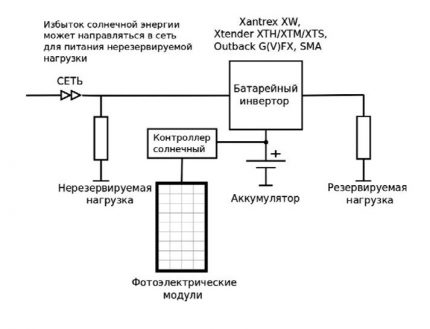
Features of the solution:
- efficient use of renewable energy in the presence / disconnection of the network;
- the ability to activate work from the solar system after the battery is discharged.
And also another solution is a slightly increased loss of energy conversion in the controller-battery-inverter section.
Option # 2 - circuit with a hybrid and network converter
Line converter at the output of the battery inverter. According to the scheme, two converters are connected to different solar panels.
The hybrid converter is connected to the optional photovoltaic panel for recharging the battery, the network is connected to the main solar module.
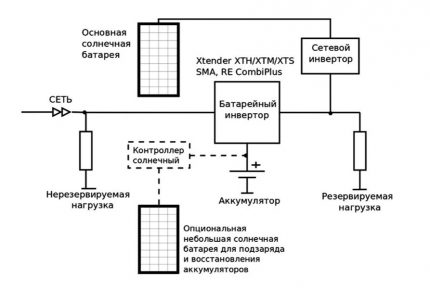
System Features:
- uninterrupted operation regardless of the presence of central mains voltage;
- high efficiency and minimization of losses on the DC side due to the sufficient level of voltage of the solar battery;
- batteries almost always operate in a buffer mode, which increases their service life;
- the use of hybrid inverters designed to charge the battery from the output;
- the need to adjust the operation of the network inverter.
The total power of the network converter should not exceed the power of the hybrid "converter" - this allows you to utilize the energy of solar panels in the event of a battery discharge, disconnecting the network.
Regardless of the selected circuit, when connecting an inverter, a number of nuances should be taken into account:
- Wired connections for DC should not be long. It is advisable to place the inverter in the vicinity (up to 3 m) from the solar panels, and then “build up” the trunk with AC.
- The converter must not be mounted on a combustible structure.
- The wall inverter is located at eye level for easy reading of information from the display.
By connecting models with a power of more than 500 watts, special requirements are made. The connection must be rigid with a reliable contact between the terminals of the device and the wires.
Also on our site there are other articles on solar energy and the connection of individual components and modules during the assembly of an autonomous system.
We recommend you to familiarize yourself with the following materials:
- Connection diagram for solar panels: to the controller, to the battery and to the serviced systems
- Solar charger: device and principle of operation of charging from the sun
- How to make a solar battery with your own hands: methods of assembly and installation of a solar panel
Conclusions and useful video on the topic
The concept of "hybrid inverter", its device, functions and options:
Overview of features, operating modes and efficiency of using the 3 kW InfiniSolar multifunction converter:
Designing a solar power system is a complex and demanding task. Calculation of the necessary parameters, the selection of the components of the heliocomplex, connection and commissioning is best left to professionals.
Mistakes made can lead to system failures and inefficient use of expensive equipment.
Choosing the best converter option for the operation of an autonomous solar energy power supply system? Do you have questions that we did not address in this article? Ask them in the comments below - we will try to help you.
Or maybe you noticed inaccuracies or inconsistencies in the material presented? Or do you want to supplement the theory with practical recommendations based on personal experience? Write to us about this, share your opinion.

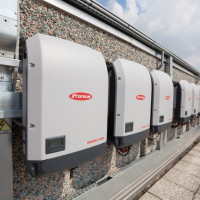 Inverter for solar panels: types of devices, model overview, connection features
Inverter for solar panels: types of devices, model overview, connection features 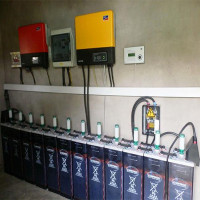 Solar batteries: an overview of the types of suitable batteries and their features
Solar batteries: an overview of the types of suitable batteries and their features  Connection diagram for solar panels: to the controller, to the battery and to the serviced systems
Connection diagram for solar panels: to the controller, to the battery and to the serviced systems 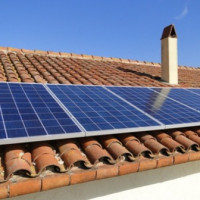 Schemes and methods of connecting solar panels: how to properly install the solar panel
Schemes and methods of connecting solar panels: how to properly install the solar panel 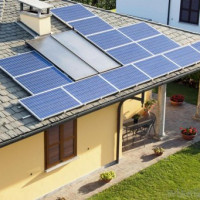 Types of solar panels: a comparative overview of designs and tips for choosing panels
Types of solar panels: a comparative overview of designs and tips for choosing panels  Solar-powered streetlights: views, manufacturers overview and comparison
Solar-powered streetlights: views, manufacturers overview and comparison  How much does it cost to connect gas to a private house: the price of organizing gas supply
How much does it cost to connect gas to a private house: the price of organizing gas supply  The best washing machines with dryer: model rating and customer tips
The best washing machines with dryer: model rating and customer tips  What is the color temperature of light and the nuances of choosing the temperature of the lamps to suit your needs
What is the color temperature of light and the nuances of choosing the temperature of the lamps to suit your needs  Replacement of a geyser in an apartment: replacement paperwork + basic norms and requirements
Replacement of a geyser in an apartment: replacement paperwork + basic norms and requirements
When choosing the right and high-quality inverter, you can even make money on your eco-house. The biggest problem for Russia in the case of organizing a completely non-volatile home is the lack of a “green tariff”, thanks to which it will be possible to sell surplus energy to the network. And so the concept of an eco-house is very attractive for the Far East, where there is a lot of sun and unreasonable territories.
And what's the problem? There is not so much sun per year, you can save energy, so that you can use it later. This is not a problem at all. Do you want to blame the country for everything? And then, for example, if such a law existed, you would have sold all the electricity in case of need, and then what to do in the winter or someday? Also a very controversial opportunity. Another thing is that in general we are very behind. But exaggerating the problem in everything is not worth it.
Just the same problem is that the “green tariff” has not been adopted in Russia at the legislative level. For the third year already, a bill has been actively discussed, which, by the way, is well thought out.
The essence of this bill is that the government wants to regulate the production of electricity at micro-generation facilities with a capacity of up to 15 kW. It is such power that was chosen because the connection of such stations will not entail beyond the permissible loads on the power grid.
For example, in neighboring Ukraine, for several years now, residents have been taking advantage of the “green tariff” by selling surplus electricity to the state. This is especially true at the peak of the performance of solar panels, from May to August, when there really is an opportunity to sell surplus electricity at the “green tariff”.